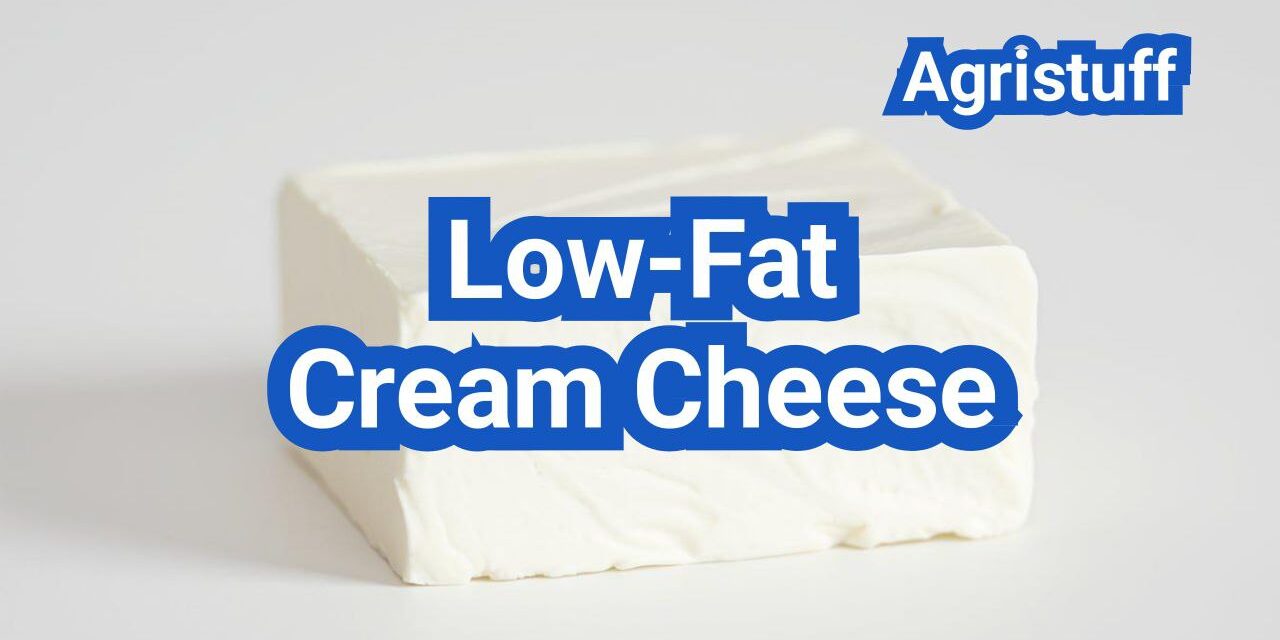Cream cheese is a soft, unripened cheese described by the FAO/WHO Standard C31 as possessing a mild, creamy flavor and aroma. With the rise of health-conscious consumers, low-fat cream cheese has become a popular alternative to traditional cream cheese.
The processing of low-fat cream cheese involves modifying the traditional cream cheese recipe to reduce its fat content while maintaining its characteristic taste and texture. This is achieved through the use of lower-fat dairy products and careful balancing of the cheese’s composition.
Understanding the differences between low-fat cream cheese and regular cream cheese is essential for choosing the right ingredient for your recipes. Not only does it offer a healthier alternative, but it also opens up new possibilities for cooking and baking.
Key Takeaways
- Low-fat cream cheese is a healthier alternative to traditional cream cheese.
- The processing involves reducing the fat content while maintaining the characteristic taste.
- It’s ideal for recipes where a lighter version is desired.
- Low-fat cream cheese can be used in various dishes, from spreads to baked goods.
- Nutritionally, it offers fewer calories compared to regular cream cheese.
Understanding Cream Cheese Basics
Cream cheese has become a staple in many cuisines around the world, but its origins and traditional definition are less well-known. To appreciate the nuances of its low-fat variations, it’s essential to understand what cream cheese is at its core.
What Defines Traditional Cream Cheese
Traditional cream cheese is characterized by its soft, creamy texture and mild, slightly tangy flavor. It is made from a mixture of cream and milk, with added bacterial culture to achieve its distinctive taste and texture. The International Dairy Foods Association provides guidelines on its production, emphasizing the importance of quality ingredients and precise manufacturing processes.
The History and Evolution of Cream Cheese
The history of cream cheese dates back to the late 19th century in the United States, where it was first produced commercially. According to historical data, the per capita consumption of cream cheese was 1.53 lbs per person in 1988, increasing to 2.07 lbs per person by 1993, as reported by the International Dairy Foods Association. This growth indicates a rising popularity and evolving consumer preferences towards cream cheese.
Over time, cream cheese has evolved to include various flavors and fat content options, catering to diverse dietary needs and culinary applications. Understanding this evolution helps in appreciating the versatility of cream cheese in modern cuisine.
What Is Low-Fat Cream Cheese?

Low-fat cream cheese has become a popular choice for health-conscious consumers who still want to enjoy the rich taste and versatility of traditional cream cheese.
Definition and Standards
Low-fat cream cheese is defined by its reduced fat content compared to the traditional version. According to the FDA, to be labeled as “low-fat,” cream cheese must contain no more than 3 grams of fat per serving. This is achieved by adjusting the amount of cream used in its production or by adding other ingredients that help maintain its texture and taste.
Key characteristics of low-fat cream cheese include:
- Lower fat content
- Similar texture to regular cream cheese
- Potential addition of stabilizers or emulsifiers
Fat Content Comparison
To understand the difference, let’s compare the fat content of regular and low-fat cream cheese:
| Type of Cream Cheese | Fat Content per Serving |
|---|---|
| Regular Cream Cheese | 9-10 grams |
| Low-Fat Cream Cheese | 3 grams or less |
As shown in the table, low-fat cream cheese significantly reduces the fat intake, making it a preferable option for those on a diet or with specific dietary needs.
According to a dairy expert, “The development of low-fat cream cheese has been a game-changer for consumers looking for healthier alternatives without compromising on taste.”
“The key to a successful low-fat cream cheese is maintaining its creamy texture while reducing the fat content.”
This is achieved through careful formulation and the use of modern dairy technology.
The Manufacturing Process of Low-Fat Cream Cheese
The production of low-fat cream cheese involves a nuanced process that differentiates it from its traditional counterpart. This process is crucial for achieving the desired taste, texture, and quality in the final product.
Traditional Cream Cheese Production
Traditionally, cream cheese is made by adding a bacterial culture to a mixture of cream and milk, allowing it to ferment, and then heating it to separate the curds from the whey. The main processing steps include milk standardization, homogenization, and the addition of a starter culture. Milk standardization ensures the right balance of fat and protein, while homogenization guarantees a uniform texture.
Modifications for Low-Fat Varieties
To produce low-fat cream cheese, manufacturers make several key modifications to the traditional process. The fat content is reduced by using less cream and more milk or by adding milk protein concentrate. This adjustment affects the product’s texture and taste, necessitating further modifications.
One common approach is to add stabilizers and emulsifiers, such as carrageenan or xanthan gum, to improve the product’s stability and texture. These additives help to compensate for the loss of fat, ensuring that the low-fat version remains smooth and spreadable.
Role of Stabilizers and Emulsifiers
Stabilizers and emulsifiers play a critical role in low-fat cream cheese production. They help to maintain the product’s consistency and prevent separation or graininess. By incorporating these ingredients, manufacturers can achieve a product that is not only lower in fat but also comparable in quality to its traditional counterpart.
The use of stabilizers and emulsifiers is a key factor in the successful production of low-fat cream cheese, enabling consumers to enjoy a healthier alternative without compromising on taste or texture.
Nutritional Profile of Low-Fat Cream Cheese

Understanding the nutritional profile of low-fat cream cheese is crucial for making informed dietary choices. Low-fat cream cheese has become a popular alternative to traditional cream cheese, offering a similar taste and texture with fewer calories.
Calorie Comparison
One of the primary reasons consumers opt for low-fat cream cheese is to reduce their calorie intake. For instance, Philadelphia Low-Fat Cream Cheese contains 20 calories per 15g serving, compared to 40 calories per 15g serving for the original version. This significant reduction makes it an attractive option for those monitoring their calorie consumption.
- Low-fat cream cheese: 20 calories/15g
- Regular cream cheese: 40 calories/15g
Protein, Calcium, and Other Nutrients
Beyond calorie counts, low-fat cream cheese is also a source of essential nutrients. It contains protein, which is vital for muscle repair and growth, and calcium, crucial for bone health. Additionally, it provides other nutrients that contribute to a balanced diet.
| Nutrient | Low-Fat Cream Cheese (per 15g) | % Daily Value |
|---|---|---|
| Protein | 2g | 4% |
| Calcium | 20mg | 2% |
Daily Value Percentages
When evaluating the nutritional profile of low-fat cream cheese, it’s also important to consider the daily value percentages of its components. While it may not be a significant source of vitamins or minerals on its own, it can contribute to a balanced diet when consumed alongside other nutrient-rich foods.
In conclusion, low-fat cream cheese offers a nutritional profile that is appealing to those seeking to reduce their calorie intake without sacrificing flavor. Its protein and calcium content add to its nutritional value, making it a worthwhile consideration for health-conscious consumers.
Low-Fat Cream Cheese vs. Regular Cream Cheese
Understanding the differences between low-fat and regular cream cheese can help home cooks and bakers make informed decisions.
Low-fat cream cheese and regular cream cheese differ significantly in terms of their composition, which affects their taste and texture. Low-fat cream cheese has a lighter and less creamy texture compared to full-fat cream cheese.
Taste and Texture Differences
The taste and texture differences between low-fat and regular cream cheese are notable. Regular cream cheese is rich and creamy, making it ideal for certain recipes. In contrast, low-fat cream cheese is less rich but still offers a tangy flavor profile.
- Regular cream cheese has a higher fat content, making it more suitable for baking and cooking applications where a rich texture is desired.
- Low-fat cream cheese, on the other hand, is a better option for those looking to reduce their fat intake without sacrificing flavor.
Cooking Performance Comparison
When it comes to cooking performance, both types of cream cheese have their advantages. Regular cream cheese provides a richer texture, while low-fat cream cheese can be a healthier alternative without compromising too much on taste.
Here are some key differences in cooking performance:
- Low-fat cream cheese may not provide the same level of browning as regular cream cheese in baked goods.
- It can be more prone to separating when heated, so it’s essential to stabilize it with other ingredients.
Low-Fat Cream Cheese vs. Neufchâtel

Low-fat cream cheese and Neufchâtel, while similar, have distinct differences in their history and composition. Understanding these differences is essential for making informed choices in cooking and dietary planning.
Historical and Cultural Differences
Neufchâtel originates from Normandy, France, and has been produced since the 6th century. It is one of the oldest cheeses in France, with a rich history and cultural significance. In contrast, cream cheese, including its low-fat version, is an American invention, dating back to the late 19th century.
Neufchâtel has traditionally been made with a higher fat content compared to low-fat cream cheese. According to the USDA, Neufchâtel must contain at least 20% but less than 33% fat and have a maximum moisture content of 65%.
Composition and Taste Comparison
The composition of low-fat cream cheese and Neufchâtel differs significantly. Low-fat cream cheese is made to have a reduced fat content compared to regular cream cheese, typically around 50% less fat. Neufchâtel, on the other hand, has a slightly higher fat content than low-fat cream cheese but is still considered a relatively low-fat option.
| Cheese Type | Fat Content | Moisture Content |
|---|---|---|
| Low-Fat Cream Cheese | Reduced fat, typically around 50% less | Varies, typically higher than Neufchâtel |
| Neufchâtel | At least 20% but less than 33% | Maximum of 65% |
The taste of Neufchâtel is often described as richer and more nuanced compared to low-fat cream cheese, which can be milder and slightly sweeter. The choice between the two often comes down to personal preference and the specific requirements of a recipe.
“Cheese is milk’s leap towards immortality.” – Clifton Fadiman
, both low-fat cream cheese and Neufchâtel offer unique qualities that can enhance various dishes, from cheesecakes to dips and spreads.
Popular Low-Fat Cream Cheese Brands
Among the many low-fat cream cheese brands available, some have gained significant popularity among consumers looking for healthier alternatives without compromising on taste.
Philadelphia Reduced Fat Cream Cheese
Philadelphia Reduced Fat Cream Cheese is a well-known brand that offers a lower-fat version of its traditional cream cheese. It is made with less fat but still maintains the signature creamy texture that Philadelphia is known for. This product is widely available in most supermarkets and is a popular choice among consumers.
Store Brands
Many store brands, such as Tesco and Asda, offer their own versions of low-fat cream cheese. These products are often priced competitively and provide consumers with affordable alternatives to name-brand products. For instance, Tesco’s own brand low-fat cream cheese is a popular choice among UK consumers.
| Brand | Fat Content | Price Range |
|---|---|---|
| Philadelphia Reduced Fat | 20% less fat | $3-$5 |
| Tesco Low-Fat Cream Cheese | 25% less fat | $2-$4 |
| Asda Reduced Fat Cream Cheese | 30% less fat | $2.5-$4.5 |
Specialty and Organic Options
For consumers looking for organic or specialty low-fat cream cheese, there are several options available. Brands that specialize in organic products offer low-fat cream cheese made from organic milk, catering to the growing demand for organic dairy products.
In conclusion, the variety of low-fat cream cheese brands available in the market caters to different consumer preferences and dietary needs. Whether it’s a well-known brand like Philadelphia or a store brand, consumers have a range of options to choose from.
How to Select the Best Low-Fat Cream Cheese

With numerous low-fat cream cheese options available, selecting the best one requires a careful examination of labels and marketing claims. Consumers should be equipped with the knowledge to discern between products that meet their dietary needs and those that don’t.
Reading Labels Effectively
When selecting a low-fat cream cheese, the nutrition label is a crucial resource. Check the fat content to ensure it aligns with your dietary requirements. Additionally, be mindful of the ingredient list; products with fewer, more natural ingredients are often preferable.
Look for certifications like “low-fat” or “reduced-fat” and verify the percentage of fat reduction. Understanding the serving size is also vital to accurately assess nutritional intake.
Understanding Marketing Claims
Marketing claims can be misleading. Terms like “natural” or “healthy” don’t always mean the product is the best choice. Verify these claims against the nutrition label and ingredient list.
For instance, a product labeled as “low-fat” might be high in sugar or sodium. Be aware of such trade-offs and choose products that balance various nutritional aspects.
Storing and Handling Low-Fat Cream Cheese

To enjoy low-fat cream cheese at its best, it’s essential to store it correctly. Proper storage maintains its quality and extends its shelf life.
Proper Storage Techniques
Low-fat cream cheese should be stored in the refrigerator at a temperature below 40°F (4°C). It’s best kept in its original packaging or wrapped tightly in plastic wrap or aluminum foil to prevent drying out.
According to dairy experts, “Proper refrigeration is key to maintaining the freshness of cream cheese.”
“Refrigeration at a consistent temperature below 40°F (4°C) slows down bacterial growth, keeping the cream cheese fresh for a longer period.”
Dairy Council
Shelf Life Considerations
The shelf life of low-fat cream cheese varies depending on storage conditions and packaging. Generally, unopened low-fat cream cheese can last several weeks in the refrigerator. Once opened, it’s best consumed within a few weeks.
| Storage Condition | Shelf Life |
|---|---|
| Unopened, Refrigerated | Several weeks |
| Opened, Refrigerated | A few weeks |
Signs of Spoilage
Check for signs of spoilage before consuming low-fat cream cheese. Visible mold, slimy texture, or an off smell are indicators that it’s gone bad.
By following these storage and handling tips, you can enjoy your low-fat cream cheese while it’s fresh and safe to eat.
Cooking with Low-Fat Cream Cheese

When it comes to cooking with low-fat cream cheese, understanding its unique characteristics is key to achieving the best results. Low-fat cream cheese can be a great substitute in many recipes, but it may require some adjustments to get the desired outcome.
Temperature Considerations
One important aspect to consider when cooking with low-fat cream cheese is temperature. Because it has a higher water content than regular cream cheese, it can be more prone to separating when heated. To avoid this, it’s best to heat it gently and gradually.
For example, when making a sauce or dip, start by heating the low-fat cream cheese over low heat, stirring constantly. This will help to prevent it from breaking and ensure a smooth texture.
Substitution Ratios
When substituting low-fat cream cheese for regular cream cheese in a recipe, it’s generally best to use a 1:1 ratio. However, you may need to adjust the amount of liquid in the recipe to compensate for the higher water content of the low-fat version.
“The key to successful substitution is understanding the role that cream cheese plays in the recipe and making adjustments accordingly.”
Texture Adjustments
Low-fat cream cheese can be softer and more prone to spreading than regular cream cheese. To achieve the desired texture, you may need to adjust the amount of liquid or add a stabilizer such as cornstarch or gelatin.
| Recipe | Adjustment |
|---|---|
| Dips and Spreads | Add a stabilizer like cornstarch or gelatin |
| Sauces | Reduce liquid content or add thickening agents |
| Baked Goods | Adjust leavening agents or add extra structure with eggs or flour |
Cooking with low-fat cream cheese requires some creativity and flexibility, but with these tips, you can achieve delicious results. Experiment with different recipes and techniques to find what works best for you.
Baking with Low-Fat Cream Cheese

The key to successful baking with low-fat cream cheese lies in understanding its unique properties and how to work with them. Low-fat cream cheese can be a versatile ingredient in various baked goods, offering a lighter alternative to traditional recipes.
Cheesecake Adaptations
When making cheesecakes with low-fat cream cheese, it’s essential to consider the potential effects on texture and flavor. Reducing the fat content can result in a slightly different texture, but this can be mitigated by adjusting other ingredients. For instance, adding an extra egg or using a combination of low-fat cream cheese with Greek yogurt can help maintain the cheesecake’s creaminess.
Other Baked Goods
Low-fat cream cheese can be used in a variety of baked goods beyond cheesecakes, such as muffins, cakes, and cookies. When substituting regular cream cheese with low-fat in recipes, it’s crucial to adjust the liquid content to achieve the right consistency. A general rule is to reduce the amount of other liquids in the recipe to compensate for the higher moisture content in low-fat cream cheese.
| Baked Good | Adjustment Needed | Benefit |
|---|---|---|
| Cheesecake | Add extra egg or Greek yogurt | Maintains creaminess |
| Muffins/Cakes | Reduce liquid content | Prevents sogginess |
| Cookies | Chill dough to prevent spread | Maintains shape |
Troubleshooting Common Issues
Common issues when baking with low-fat cream cheese include texture problems and flavor inconsistencies. To troubleshoot, check the ratio of cream cheese to other ingredients and ensure that you’re not overmixing the batter. Using room temperature ingredients can also help in achieving a smooth and even texture.
By understanding these adaptations and adjustments, bakers can successfully incorporate low-fat cream cheese into their recipes, creating delicious and healthier baked goods.
Savory Recipes Using Low-Fat Cream Cheese

With its creamy texture and mild flavor, low-fat cream cheese is ideal for savory cooking. It can be used to make a variety of dishes, from dips and spreads to main courses and appetizers.
Dips and Spreads
Low-fat cream cheese makes an excellent base for dips and spreads. For example, you can mix it with herbs and spices to create a delicious spinach and artichoke dip. Simply combine softened low-fat cream cheese with cooked spinach, artichoke hearts, garlic, and your choice of seasonings, then bake until warm and bubbly.
Another option is a roasted red pepper dip, made by blending roasted peppers with low-fat cream cheese, lemon juice, and a pinch of salt. Serve with crackers or vegetable sticks for a healthy snack.
Main Dishes
Low-fat cream cheese can also be incorporated into main dishes to add creaminess and depth. A classic example is a creamy pasta sauce, where low-fat cream cheese is melted with Parmesan cheese, garlic, and herbs, then tossed with cooked pasta.
You can also use low-fat cream cheese to make a savory stuffed chicken breast. Simply mix softened low-fat cream cheese with chopped herbs, garlic, and a pinch of salt, then stuff it inside chicken breasts before baking.
Appetizers and Snacks
For appetizers and snacks, low-fat cream cheese can be used to make a variety of delicious treats. One idea is to spread low-fat cream cheese on crackers, then top with smoked salmon, capers, and thinly sliced red onion.
Another option is to mix low-fat cream cheese with diced jalapeños and shredded cheese, then fill mini bell peppers with the mixture and bake until tender.
| Recipe | Main Ingredients | Prep Time |
|---|---|---|
| Spinach and Artichoke Dip | Low-fat cream cheese, spinach, artichoke hearts | 15 minutes |
| Creamy Pasta Sauce | Low-fat cream cheese, Parmesan cheese, garlic | 10 minutes |
| Stuffed Chicken Breast | Low-fat cream cheese, chicken breasts, herbs | 20 minutes |
These are just a few examples of the many savory recipes you can make using low-fat cream cheese. Its versatility and mild flavor make it a great addition to a wide range of dishes.
Sweet Recipes Using Low-Fat Cream Cheese

Low-fat cream cheese opens up a world of possibilities for sweet recipes, from desserts to breakfast dishes. This versatile ingredient can be used to create a variety of delicious treats that are not only tasty but also healthier than their full-fat counterparts.
Desserts Beyond Cheesecake
While cheesecake is a classic dessert that uses cream cheese, there are many other sweet treats you can make with low-fat cream cheese. Some ideas include:
- Creamy fruit parfaits
- Low-fat cream cheese-based mousse
- Cheesecake bars with a graham cracker crust
These desserts are perfect for anyone looking to reduce their fat intake without sacrificing flavor.
Frostings and Fillings
Low-fat cream cheese makes an excellent base for frostings and fillings. It can be mixed with powdered sugar and vanilla extract to create a delicious frosting for cakes and cupcakes. You can also use it as a filling for pastries and Danish rolls.
Some tips for making the perfect frosting include:
- Beat the cream cheese until it’s smooth
- Add powdered sugar gradually to avoid lumps
- Use a high-quality vanilla extract for the best flavor
Breakfast Applications
Low-fat cream cheese isn’t just for desserts; it can also be used in breakfast dishes. Try using it in:
- Cream cheese-stuffed French toast
- Low-fat cream cheese and fruit-filled crepes
- Cream cheese-based breakfast strata
These breakfast ideas are not only delicious but also provide a good balance of protein and flavor to start your day.
Alternatives to Low-Fat Cream Cheese
For those looking to further reduce their fat intake or explore different flavors, there are several alternatives to low-fat cream cheese available. These alternatives can offer unique nutritional profiles and culinary uses.
Fat-Free Cream Cheese
Fat-free cream cheese is a direct alternative to low-fat cream cheese, offering an even lower fat content. It’s ideal for those who are watching their calorie intake closely. However, the fat reduction can affect the texture and taste, making it slightly more processed-tasting than its low-fat counterpart.
Greek Yogurt and Skyr
Greek yogurt and Skyr are high-protein alternatives that can be used in many recipes that call for cream cheese. They offer a tangy flavor and a creamy texture, although they are more suited to certain types of dishes, such as dips and spreads.
| Product | Fat Content | Protein Content |
|---|---|---|
| Low-Fat Cream Cheese | Low | Moderate |
| Fat-Free Cream Cheese | Very Low | Moderate |
| Greek Yogurt | Variable | High |
Cottage Cheese and Quark
Cottage cheese and quark are other alternatives that can be used in place of cream cheese in some recipes. They have a different texture and can add a unique flavor to dishes. Cottage cheese, for example, is great for those looking to increase their protein intake.
When choosing an alternative to low-fat cream cheese, consider the specific requirements of your recipe and the nutritional profile you’re aiming for. Experimenting with these alternatives can lead to new favorite dishes and a more varied diet.
Health Considerations When Using Low-Fat Cream Cheese
The health considerations of low-fat cream cheese are multifaceted, involving both benefits and drawbacks. As consumers become increasingly health-conscious, understanding these aspects is crucial for making informed dietary choices.
Benefits for Various Dietary Needs
Low-fat cream cheese can be particularly beneficial for individuals looking to reduce their fat intake. It is often lower in calories and saturated fats compared to its full-fat counterpart, making it a popular choice for those on weight management diets or with heart health concerns.
Nutritional Benefits: It remains a good source of protein and calcium, essential nutrients for muscle and bone health. Some brands also fortify their low-fat cream cheese products with additional vitamins and minerals, enhancing their nutritional profile.
“Choosing low-fat cream cheese can be a strategic move for those monitoring their calorie intake, but it’s essential to consider the overall nutritional context.” – Nutrition Expert
Potential Drawbacks
Despite its benefits, low-fat cream cheese may have some drawbacks. One of the primary concerns is the potential addition of artificial ingredients to enhance flavor and texture, which some consumers may wish to avoid.
- Added sugars or salt for taste enhancement
- Thickeners and stabilizers to improve texture
- Preservatives to extend shelf life
Consumers should be aware of these additives by carefully reading product labels.
Balancing Taste and Health
One of the challenges of using low-fat cream cheese is achieving a balance between health considerations and taste preferences. While it offers a healthier alternative, some users find the taste and texture less appealing than full-fat versions.
| Aspect | Low-Fat Cream Cheese | Regular Cream Cheese |
|---|---|---|
| Fat Content | Reduced fat, lower calories | Full fat, higher calories |
| Taste and Texture | May be less rich, potentially containing additives | Rich and creamy, natural taste |
| Nutritional Value | Good source of protein and calcium, potentially lower in vitamins | Good source of protein, calcium, and fat-soluble vitamins |
To strike a balance, consumers can experiment with different brands and recipes, combining low-fat cream cheese with other ingredients to enhance flavor and texture.
At The End of: Low-Fat Cream Cheese
Low-fat cream cheese has emerged as a valuable ingredient for those seeking to reduce their dietary fat intake without compromising on taste or texture. As discussed throughout this article, low-fat cream cheese offers a range of benefits, from its nutritional profile to its versatility in various recipes.
The processing and manufacturing of low-fat cream cheese involve modifications to traditional cream cheese production, including the use of stabilizers and emulsifiers. This results in a product that is not only lower in fat but also retains a desirable consistency and flavor.
Cooking with low-fat cream cheese can be a rewarding experience, as it can be used in a variety of dishes, from savory dips and spreads to sweet desserts like cheesecakes and frostings. By understanding how to substitute low-fat cream cheese in recipes and adjust cooking techniques, home cooks can create delicious and healthier meals.
In conclusion, incorporating low-fat cream cheese into one’s culinary repertoire can be a great way to balance taste and nutrition. With its numerous uses and benefits, low-fat cream cheese is an ingredient worth exploring for health-conscious cooks and bakers.
FAQ
What is the difference between low-fat cream cheese and regular cream cheese?
Low-fat cream cheese has a lower fat content compared to regular cream cheese, making it a popular choice for those looking to reduce their fat intake. The fat content in low-fat cream cheese can vary depending on the brand and type, but it is generally lower than regular cream cheese.
How is low-fat cream cheese processed?
Low-fat cream cheese is processed similarly to regular cream cheese, with some modifications to reduce the fat content. This may involve using lower-fat milk or adding stabilizers and emulsifiers to maintain the texture and consistency.
What are some popular brands of low-fat cream cheese?
Some popular brands of low-fat cream cheese include Philadelphia Reduced Fat Cream Cheese, store brands like Tesco and Kroger, and specialty and organic options.
Can I use low-fat cream cheese in baking?
Yes, low-fat cream cheese can be used in baking, but it may require some adjustments to achieve the desired texture and consistency. It’s essential to consider the temperature, substitution ratios, and texture adjustments when using low-fat cream cheese in baked goods.
How do I store low-fat cream cheese?
Low-fat cream cheese should be stored in the refrigerator at a temperature below 40°F (4°C). It’s essential to check the expiration date and signs of spoilage before consuming.
What are some alternatives to low-fat cream cheese?
Some alternatives to low-fat cream cheese include fat-free cream cheese, Greek yogurt, cottage cheese, and quark. These options can be used in various recipes, depending on the desired texture and flavor.
Is low-fat cream cheese suitable for people with dietary restrictions?
Low-fat cream cheese can be a good option for people with dietary restrictions, such as those watching their fat intake or managing calorie consumption. However, it’s essential to check the ingredient list and nutrition label to ensure it meets specific dietary needs.
Can I make my own low-fat cream cheese at home?
Yes, it’s possible to make low-fat cream cheese at home by using lower-fat milk and adjusting the processing method. However, achieving the right texture and consistency can be challenging, and it may require some experimentation.
How does low-fat cream cheese compare to Neufchâtel?
Low-fat cream cheese and Neufchâtel are both lower-fat alternatives to regular cream cheese. While they share some similarities, they have distinct differences in terms of their composition, taste, and texture.
What are some popular recipes using low-fat cream cheese?
Low-fat cream cheese can be used in a variety of recipes, including dips, spreads, cheesecakes, and baked goods. It’s a versatile ingredient that can be used in both sweet and savory dishes.
Conclusion of: Low-Fat Cream Cheese
What is low fat cream cheese?
Low fat cream cheese is a fresh, soft, spreadable dairy product that mimics the tang and versatility of classic cream cheese with less total fat. In the U.S., low fat cream cheese is formulated by reducing milkfat and increasing moisture and proteins so it still spreads smoothly and tastes familiar. Because the market is U.S.-focused, low fat cream cheese must align with federal rules on standardized cheeses and nutrient-content claims so labels are transparent for shoppers. FDA standard of identity for cream cheese
What “low fat” legally means on low fat cream cheese
On low fat cream cheese, the “low fat” claim is defined by the FDA: the food must contain 3 grams of fat or less per reference amount customarily consumed (and per 100 grams for certain foods). This is different from “reduced fat” (≥25% less fat than a reference food) and “light,” which can refer to fat or calories depending on context. Understanding these terms helps you choose the right low fat cream cheese for your goals. FDA: Nutrient-content claims for fat
How classic cream cheese differs from low fat cream cheese
Classic cream cheese must contain at least 33% milkfat and no more than 55% moisture, so it’s richer than low fat cream cheese by design. Manufacturers can pair the standardized name with a qualifying claim (e.g., “low fat cream cheese”) as long as both the standard and the claim’s criteria are met. This is why low fat cream cheese feels lighter while still behaving like a spreadable cheese. FDA: Cream cheese standard
Where Neufchâtel fits next to low fat cream cheese
In U.S. groceries, Neufchâtel is a sister style to cream cheese with less fat (often around one-third less) and higher moisture, which is why it’s frequently marketed as a lighter option. While not always identical to low fat cream cheese, many shoppers use Neufchâtel similarly in spreads and cold dips. Reading labels helps you decide between Neufchâtel and low fat cream cheese for taste and nutrition. FDA: Neufchâtel standard
Processing basics: how low fat cream cheese is made
Producers make low fat cream cheese by standardizing milk and cream, pasteurizing, then acidifying (with cultures and/or direct acid) to form a delicate gel near pH ~4.6. The curd is heated and blended for smoothness, with more moisture and proteins than full-fat versions. The result is low fat cream cheese with a mild tang, spreadable body, and refrigerator stability for everyday use. Univ. of Guelph: Fresh/acid-coagulated cheese technology
Formulation tweaks that keep low fat cream cheese creamy
Because fat supplies richness and lubrication, low fat cream cheese often relies on milk proteins (e.g., whey protein concentrates) and stabilizers (e.g., locust bean, guar, xanthan) to bind water and prevent weeping. Homogenization and hot-pack steps help create a fine, creamy microstructure so low fat cream cheese spreads cleanly on bagels and toast without tasting watery. Wisconsin Center for Dairy Research: Cream cheese overview
Nutrition snapshot: what changes in low fat cream cheese
Compared with regular cream cheese, low fat cream cheese typically has fewer calories and much less total fat per serving, with slightly more water and protein solids. Exact numbers vary by brand, so the Nutrition Facts label is your best guide. For U.S. shoppers, checking calories, total fat, and saturated fat helps position low fat cream cheese in a balanced diet. USDA FoodData Central (search “cream cheese, low fat”)
Sodium & portioning: reading low fat cream cheese labels
Low fat cream cheese usually contains modest sodium per tablespoon, but brands differ. Using a measured tablespoon helps control portions and keep sodium and calories in check while enjoying low fat cream cheese in spreads and dips. If sodium is a concern, compare panels side-by-side and look for options labeled “lower sodium” in low fat cream cheese. FDA: Sodium in your diet
Fat-free vs. low fat cream cheese
Fat-free versions can cut calories further than low fat cream cheese, but they often rely more on water-binding proteins and stabilizers, so textures can be firmer and less “melty.” For spreads and cold dips, fat-free may work; for baking or hot dishes, low fat cream cheese usually performs better than fat-free. This makes low fat cream cheese a practical middle ground. USDA FoodData Central (compare fat-free vs. low-fat)
Heart-health context for choosing low fat cream cheese
Choosing low fat cream cheese can help trim saturated fat compared with regular cream cheese. In the U.S., many adults aim to limit saturated fat as part of a heart-healthy pattern, and swapping in low fat cream cheese is one small, sustainable change that supports that goal while keeping meals enjoyable. American Heart Association: Dietary fats guidance
Food safety: pasteurization and soft cheeses
Most retail low fat cream cheese in the U.S. is made from pasteurized dairy, which is important for safety. People who are pregnant or immunocompromised should avoid soft cheeses made from unpasteurized milk; always confirm “pasteurized” on the label when buying low fat cream cheese for your home. CDC: Listeria & soft cheeses
Storage and freezing tips for low fat cream cheese
Keep low fat cream cheese refrigerated at ≤40°F and use by the “best by” date for top quality. Texture can degrade in the freezer, so freezing low fat cream cheese isn’t generally recommended unless you plan to use it in cooked dishes where smoothness matters less. USDA/FSIS FoodKeeper storage guidance
Functional differences you may notice in the kitchen
With higher moisture and lower butterfat, low fat cream cheese is tangier and a bit firmer when cold. It softens quickly at room temperature yet doesn’t “melt” like full-fat in hot applications. Stabilizers improve spreadability, but baked textures can be tighter than with regular cream cheese—so choose low fat cream cheese for the right applications. CDR: Processing & texture notes
Best everyday uses for low fat cream cheese
Low fat cream cheese shines in cold applications: bagels and toast, herb-whipped spreads, veggie and smoked-fish dips, and no-bake fillings where richness comes from spices, citrus zest, or yogurt additions. For product developers and chefs, application sheets showcase ideas that keep low fat cream cheese delicious. ThinkUSADairy: Formulas & recipes
When to keep full-fat—and how to blend with low fat cream cheese
Classic New York–style cheesecake depends on the emulsifying power of butterfat, so subbing 100% low fat cream cheese often yields a firmer, less silky crumb. A practical tweak is to replace only 25–50% with low fat cream cheese, then test and adjust sugar, starch, and bake time. This lets low fat cream cheese lower fat while preserving indulgence. Guelph: Fresh cheese behavior in recipes
Smart substitutions that complement low fat cream cheese
For savory spreads, blend equal parts low fat cream cheese and plain Greek yogurt to boost protein and lighten texture; for sweet dips, add vanilla and a touch of honey or fruit purée. Extension resources offer practical swaps so low fat cream cheese fits everyday cooking without feeling restrictive. University of Maryland Extension: Healthy recipe swaps
Label literacy for low fat cream cheese shoppers
Front-of-pack claims can be confusing, so pair them with the Nutrition Facts. If a product name uses a nutrient claim plus a standardized term—like “low fat cream cheese”—it must meet both the standard and the claim via the FDA’s 130.10 pathway. This keeps naming consistent so low fat cream cheese choices are straightforward. FDA: Naming with nutrient-content claims
Quick U.S. shopper checklist for low fat cream cheese
When you pick low fat cream cheese in the U.S., scan for: pasteurized milk, 3 g fat or less per serving if “low fat,” saturated fat grams, sodium per tablespoon, and an ingredient list you’re comfortable with (stabilizers are common). This fast check ensures low fat cream cheese fits your taste, texture, and nutrition targets. FDA: How to read the Nutrition Facts label
Bottom line on low fat cream cheese
Use low fat cream cheese for everyday spreads, cold dips, whipped fillings, stuffed chicken, omelets, and creamy vegetable sides; reserve full-fat for iconic baked cheesecakes or blend the two to balance performance and nutrition. This way, low fat cream cheese helps you cut saturated fat without giving up cream-cheese convenience. Dietary Guidelines for Americans (overview)
Final thought
Low fat cream cheese delivers familiar tang and versatility with less fat, making it a smart swap for U.S. kitchens focused on flavor and balance. Match the product to the job (cold vs. baked), lean on herbs and spices for impact, and read labels to compare brands. With small, consistent changes, low fat cream cheese helps build better everyday meals. AHA: Heart-healthy fat choices
Sources & References
- FDA 21 CFR §101.62 – Nutrient-content claims for fat
- FDA 21 CFR §133.133 – Cream cheese standard of identity
- FDA 21 CFR §133.162 – Neufchâtel
- FDA 21 CFR §130.10 – Naming with nutrient-content claims
- University of Guelph – Fresh/acid-coagulated cheeses
- Wisconsin Center for Dairy Research – Cream cheese processing overview
- USDA FoodData Central – U.S. nutrition database
- American Heart Association – Dietary fats
- USDA/FSIS – FoodKeeper storage guidance
- FDA – How to read the Nutrition Facts label
- ThinkUSADairy – Formulas & recipes
- University of Maryland Extension – Healthy recipe swaps
- Dietary Guidelines for Americans










